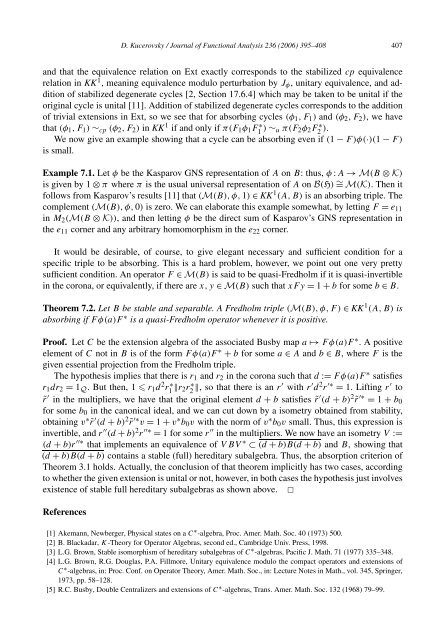Estimation optimale du gradient du semi-groupe de la chaleur sur le ...
Estimation optimale du gradient du semi-groupe de la chaleur sur le ...
Estimation optimale du gradient du semi-groupe de la chaleur sur le ...
You also want an ePaper? Increase the reach of your titles
YUMPU automatically turns print PDFs into web optimized ePapers that Google loves.
D. Kucerovsky / Journal of Functional Analysis 236 (2006) 395–408 407<br />
and that the equiva<strong>le</strong>nce re<strong>la</strong>tion on Ext exactly corresponds to the stabilized cp equiva<strong>le</strong>nce<br />
re<strong>la</strong>tion in KK 1 , meaning equiva<strong>le</strong>nce mo<strong>du</strong>lo perturbation by Jφ, unitary equiva<strong>le</strong>nce, and addition<br />
of stabilized <strong>de</strong>generate cyc<strong>le</strong>s [2, Section 17.6.4] which may be taken to be unital if the<br />
original cyc<strong>le</strong> is unital [11]. Addition of stabilized <strong>de</strong>generate cyc<strong>le</strong>s corresponds to the addition<br />
of trivial extensions in Ext, so we see that for absorbing cyc<strong>le</strong>s (φ1,F1) and (φ2,F2), wehave<br />
that (φ1,F1) ∼cp (φ2,F2) in KK 1 if and only if π(F1φ1F ∗ 1 ) ∼u π(F2φ2F ∗ 2 ).<br />
We now give an examp<strong>le</strong> showing that a cyc<strong>le</strong> can be absorbing even if (1 − F)φ(·)(1 − F)<br />
is small.<br />
Examp<strong>le</strong> 7.1. Let φ be the Kasparov GNS representation of A on B: thus, φ : A → M(B ⊗ K)<br />
is given by 1 ⊗ π where π is the usual universal representation of A on B(H) ∼ = M(K). Then it<br />
follows from Kasparov’s results [11] that (M(B), φ, 1) ∈ KK 1 (A, B) is an absorbing trip<strong>le</strong>. The<br />
comp<strong>le</strong>ment (M(B), φ, 0) is zero. We can e<strong>la</strong>borate this examp<strong>le</strong> somewhat, by <strong>le</strong>tting F = e11<br />
in M2(M(B ⊗ K)), and then <strong>le</strong>tting φ be the direct sum of Kasparov’s GNS representation in<br />
the e11 corner and any arbitrary homomorphism in the e22 corner.<br />
It would be <strong>de</strong>sirab<strong>le</strong>, of course, to give e<strong>le</strong>gant necessary and sufficient condition for a<br />
specific trip<strong>le</strong> to be absorbing. This is a hard prob<strong>le</strong>m, however, we point out one very pretty<br />
sufficient condition. An operator F ∈ M(B) is said to be quasi-Fredholm if it is quasi-invertib<strong>le</strong><br />
in the corona, or equiva<strong>le</strong>ntly, if there are x,y ∈ M(B) such that xFy = 1 + b for some b ∈ B.<br />
Theorem 7.2. Let B be stab<strong>le</strong> and separab<strong>le</strong>. A Fredholm trip<strong>le</strong> (M(B), φ, F ) ∈ KK 1 (A, B) is<br />
absorbing if F φ(a)F ∗ is a quasi-Fredholm operator whenever it is positive.<br />
Proof. Let C be the extension algebra of the associated Busby map a ↦→ F φ(a)F ∗ . A positive<br />
e<strong>le</strong>ment of C not in B is of the form F φ(a)F ∗ + b for some a ∈ A and b ∈ B, where F is the<br />
given essential projection from the Fredholm trip<strong>le</strong>.<br />
The hypothesis implies that there is r1 and r2 in the corona such that d := F φ(a)F ∗ satisfies<br />
r1dr2 = 1Q. But then, 1 r1d 2 r ∗ 1 r2r ∗ 2 , so that there is an r′ with r ′ d 2 r ′∗ = 1. Lifting r ′ to<br />
˜r ′ in the multipliers, we have that the original e<strong>le</strong>ment d + b satisfies ˜r ′ (d + b) 2 ˜r ′∗ = 1 + b0<br />
for some b0 in the canonical i<strong>de</strong>al, and we can cut down by a isometry obtained from stability,<br />
obtaining v ∗ ˜r ′ (d + b) 2 ˜r ′∗ v = 1 + v ∗ b0v with the norm of v ∗ b0v small. Thus, this expression is<br />
invertib<strong>le</strong>, and r ′′ (d + b) 2 r ′′∗ = 1forsomer ′′ in the multipliers. We now have an isometry V :=<br />
(d + b)r ′′∗ that imp<strong>le</strong>ments an equiva<strong>le</strong>nce of VBV ∗ ⊂ (d + b)B(d + b) and B, showing that<br />
(d + b)B(d + b) contains a stab<strong>le</strong> (full) hereditary subalgebra. Thus, the absorption criterion of<br />
Theorem 3.1 holds. Actually, the conclusion of that theorem implicitly has two cases, according<br />
to whether the given extension is unital or not, however, in both cases the hypothesis just involves<br />
existence of stab<strong>le</strong> full hereditary subalgebras as shown above. ✷<br />
References<br />
[1] Akemann, Newberger, Physical states on a C ∗ -algebra, Proc. Amer. Math. Soc. 40 (1973) 500.<br />
[2] B. B<strong>la</strong>ckadar, K-Theory for Operator Algebras, second ed., Cambridge Univ. Press, 1998.<br />
[3] L.G. Brown, Stab<strong>le</strong> isomorphism of hereditary subalgebras of C ∗ -algebras, Pacific J. Math. 71 (1977) 335–348.<br />
[4] L.G. Brown, R.G. Doug<strong>la</strong>s, P.A. Fillmore, Unitary equiva<strong>le</strong>nce mo<strong>du</strong>lo the compact operators and extensions of<br />
C ∗ -algebras, in: Proc. Conf. on Operator Theory, Amer. Math. Soc., in: Lecture Notes in Math., vol. 345, Springer,<br />
1973, pp. 58–128.<br />
[5] R.C. Busby, Doub<strong>le</strong> Centralizers and extensions of C ∗ -algebras, Trans. Amer. Math. Soc. 132 (1968) 79–99.

















